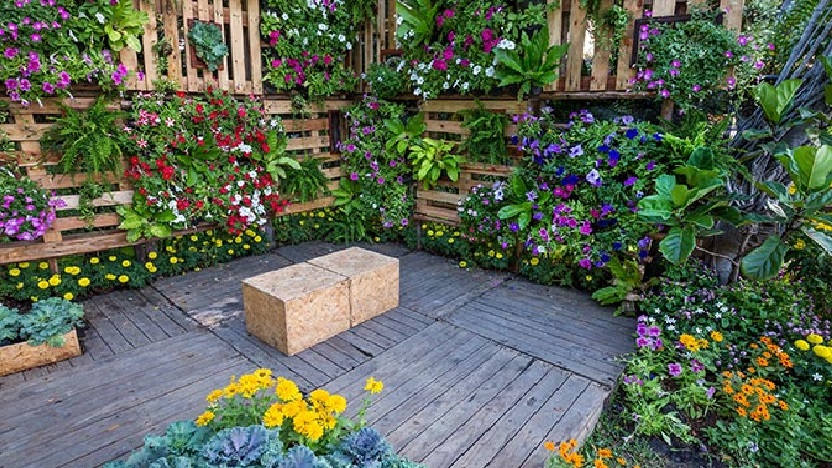| Welcome to the Inside Farm. Survival Plus, Prepping and Much More. |
|||||
| 12 Budget-friendly tips for creating a beautiful garden. | |||||
| By: Divina Ramirez
(Natural News) Stunning gardens are a treat for the senses. Fragrant flowers, colorful fences and weed-free beds help create an inviting garden for humans, birds and insects alike. Beginner gardeners might shrink at the idea of creating a garden that’s both functional and beautiful. However, it’s not as difficult as it seems. And it shouldn’t burn a hole in your pocket either. From planting perennials to painting fences, here are some tips for creating a beautiful garden: 1. Grow flowers from seedsFlowers, such as pansies, daffodils and marigolds, add vibrant colors to your garden. But you can burn through your budget by purchasing flowering plants alone. So start flowers from seeds instead. You may need to wait for a couple of months before you have a vibrant garden, but you will save yourself money in the process. 2. Plant more perennialsFlowers make a pretty addition to a garden, but some varieties can be immensely high-maintenance. Generally speaking, perennials require much less maintenance than annuals. In addition, perennials regrow each spring, whereas annuals live for only one growing season. Therefore, you’ll save more money planting perennials than annuals. Certain herbs and wildflowers are also perennials. You may want to consider growing some on your flower beds for some variety. They attract butterflies, too. 3. Plant treesDon’t be afraid to mix up your greenery by adding trees. Trees keep your garden from looking flat because they add height to your garden. If you have a small garden space, smaller trees like crabapples, peaches and figs. You can also plant some tall shrubs and create topiaries for variety. 4. Use lawn edgingEdging allows you to create clean, crisp lines between beds and other areas in your garden. These lines define a flower border, a shrub bed, a single tree or the transition from your patio to the garden. You don’t have to spend a fortune though. Get creative and use plastic pipes or recycled rubber tires to create edging. 5. Create a gravel path in the gardenGravel paths add character to your garden, particularly when combined with edging. Gravel is a cheap material so don’t be afraid to go all out. If laying a gravel path on soil, lay down some garden fabric or newspaper to prevent pesky weeds from growing underneath the gravel. 6. Paint fences and garden shedsIf your garden looks dull even with flowers and shrubs, it might be time to work on the fences and structures in your garden. Spruce them up by coating them with a fresh coat of paint in a color that complements your plants. You can also go the extra mile and refurbish worn-down structures like sheds or gazebos. 7. Place decorative features throughout the gardenDecorative pieces like boulders, lattice dividers and plant stands can complement flower beds, herb pots, paths and more when positioned strategically. You can buy worn-down pieces or build them from scratch. For virtually zero-cost decorations, let moss grow on large rocks or place vining plants near fences and walls. 8. Set up a birdbathLike bees and butterflies, birds bring life to a garden. They also eat pests that may otherwise destroy your beds. To attract birds to your garden, set up a birdbath somewhere cool and shaded. Make sure to replenish the water every day. Place some stones or twigs in the birdbath so that the birds have things to stand on. 9. Install garden lightingLanterns, path lights and string lights help illuminate the garden at night. When lit up against trees, sculptures, shrubs and flower beds, lighting helps create yet another attractive dimension to your garden. Battery-operated and solar-powered lighting are among the cheapest lighting options available. 10. Build a pondBuilding a pond is another great way to bring more wildlife into your garden. Pick a spot, dig a hole, line it with pond liner at the bottom and decorate with small rocks and pebbles. Fill it with water and add a fountain pump if desired. Follow this guide for more detailed instructions. 11. Install outdoor hanging basketsHanging baskets, pots and planter boxes aren’t just for patios or indoor gardens. You can use them to create an illusion of height and dimension to your garden space. For budget-friendly baskets, repurpose old bottles, broken cookware, tins, spare wooden boxes or even coconut husks. 12. Get rid of weedsWeeds are a gardener’s worst nightmare. These pesky plants can ruin a flower bed and crowd out garden crops. One of the best ways of keeping your garden looking stunning is to pull out weeds as soon as they appear. It may also help to conduct weekly inspections of your garden to check thoroughly for any weed growth. The natural methods detailed below can prevent weeds from taking over your garden. Pulling weedsPulling weeds by hand may be hard on your back and knees, but it’s a tried-and-tested method of getting rid of weeds. It’s also one of the best methods to use if you have weeds that grew too close to your crops since you don’t have to worry about accidentally damaging the plants that you want to keep alive. Here are some tips you can follow when weeding by hand:
MulchUse mulch to smother out existing weeds in your garden. Mulch can also prevent new weeds from sprouting. Additionally, mulch improves soil quality and encourages the growth of your crops. Old newspapersLike mulch, old newspapers can smother weeds. Lay down some old newspapers around your plants to prevent weeds from growing. Newspapers will also boost soil quality in your garden. Vodka or rubbing alcoholAlcohol and sunlight are a deadly combination for weeds. Sunlight makes alcohol lethal to plants that it comes into contact with. Moreover, alcohol’s drying properties pull the moisture from leaves, leaving the weeds to wither. Make a natural, non-toxic herbicide by combining two ounces of vodka or rubbing alcohol, two cups of water, and several drops of dish soap. The dish soap boosts the effectiveness of the mixture by drying out the leaves even more. Be careful when using this mixture, and don’t spray any on the plants that you want to grow. VinegarUnlike the alcohol mixture above, you need to apply vinegar several times for best results, especially when dealing with weeds that have a long taproot (e.g., dandelions). (Related: A natural herbicide that really works.) Make a vinegar-based weed-killer by mixing a gallon of white household vinegar, one cup of table salt, and a tablespoon of dish soap. Spray the mixture directly on the weeds. Re-apply until the weeds wither. Don’t spray the mixture directly on the soil. Both salt and vinegar will prevent anything from growing in that spot for a long time. Plastic sheetingYou can use plastic sheeting to apply a method called soil solarization. To solarize your garden, place plastic sheeting around the base of your plants. This method uses the greenhouse effect to “cook” the weeds beneath the sheeting. The plants above the sheeting will be unharmed. Take note that solarizing is effective only in areas exposed to full sunlight. Corn glutenSprinkle corn gluten over the soil in your garden to prevent new weeds from germinating. This method won’t harm garden plants that have already sprouted and those that have already germinated. Combine corn gluten with other methods to boost its effectiveness. Corn gluten also adds nitrogen, which boosts soil health. CrowdingCrowding is another effective weed control method because plants can’t grow if there isn’t any room for them. Plant crops in your garden as closely together as possible. Once your plants have reached maturity, their leaves will block out most of the sunlight from reaching the ground beneath them. This prevents weeds from growing around them. SaltSprinkling a few pinches of salt around the base of weeds will dehydrate and kill them. This also prevents weeds from growing back. However, you must use this method with caution because the salt will prevent anything else from growing in the same spot for a long time. Don’t get salt near the base of your crops Learn more about creating a functional and beautiful garden at HomeGardeningNews.com. Sources include: |
|||||
| 🌻 Bypass censorship by sharing one of these links: https://insidefarmer.com/in-farm-07/ or https://box91.com/in-farm-07/ or https://box127.com/in-farm-07/ or https://box145.com/in-farm-07/ or https://box154.com/in-farm-07/ or https://1realnews.com/in-farm-07 |
|||||
Daily Updates
Copyright © 2024 100% Real News Plus















